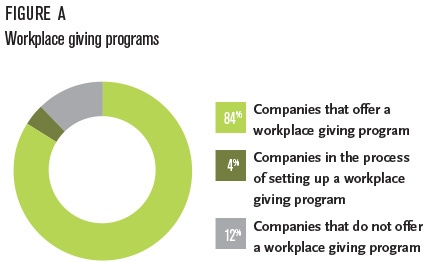 The holiday season is upon us, and with it comes an increased focus on corporate giving initiatives. From localized donations such as food and toy drives to broader efforts like the annual #GivingTuesday campaign, companies are ramping up their corporate giving programs. As our calendar year comes to an end and many are moving into new budget cycles this spring, it is a good time to assess your giving strategy and make sure it is designed to maximize both social and business value. All giving is good AND you can increase the effectiveness of your company’s giving program by employing the resources and capabilities unique to you, addressing the causes most relevant to your business operating context, and mobilizing your employees. If you activate your program on all three of these fronts, you will make an impact that continues well beyond the holidays.
The holiday season is upon us, and with it comes an increased focus on corporate giving initiatives. From localized donations such as food and toy drives to broader efforts like the annual #GivingTuesday campaign, companies are ramping up their corporate giving programs. As our calendar year comes to an end and many are moving into new budget cycles this spring, it is a good time to assess your giving strategy and make sure it is designed to maximize both social and business value. All giving is good AND you can increase the effectiveness of your company’s giving program by employing the resources and capabilities unique to you, addressing the causes most relevant to your business operating context, and mobilizing your employees. If you activate your program on all three of these fronts, you will make an impact that continues well beyond the holidays.
Corporate giving, whether through a foundation, noncash contributions such as pro bono service or product donations, or cash directly from the company, can improve your corporate reputation, consumer support, and employee loyalty. The trick is determining which cause(s) resonate with your stakeholders, and which causes you are best suited to address. Then, you select those causes that fall into both categories.
Consider how many causes you’re prepared to commit to. Can you manage all of them effectively? Do you have the processes in place to track not only your donations, but also the outcomes and impacts that they will achieve? This information is vital to communicating the value of your efforts—not only to your C-Suite, but also to your broader audiences.
Also, take the time to vet your nonprofit recipients carefully. Does the nonprofit recipient share your company’s focus? Do they have a track record of delivering similar projects? How is their financial health? Our 2015 Community Involvement Study offers a step-by-step guide to evaluating nonprofit partners.
Once you’ve selected your causes, and decided on your partners, be sure to engage your employees. A 2016 study finds that employees who are involved in their company’s corporate giving efforts have a stronger attachment to the company, and are more likely to advocate for it.[i] For many companies, engagement is achieved through workplace giving programs, which have been found to increase job satisfaction as a result of participating employees’ stronger commitment to and an improved perception of their companies.[ii]
With such impressive organizational benefits, it’s no surprise that many firms offer workplace giving programs. In the Boston College Center for Corporate Citizenship’s 2015 Community Involvement Study, more than 80 percent of companies offered them (see Figure A), and nearly 80 percent of companies provided a match to employee contributions.
 A 2013 study finds that, while recognition may not motivate all employees to give —it in no way hurts engagement levels for those unmoved by acknowledgement. For those who are positively affected, the gains achieved by offering both public and private recognition are impressive, bringing participation up as much as 15 percentage points.[iii]
A 2013 study finds that, while recognition may not motivate all employees to give —it in no way hurts engagement levels for those unmoved by acknowledgement. For those who are positively affected, the gains achieved by offering both public and private recognition are impressive, bringing participation up as much as 15 percentage points.[iii]
Employee engagement in giving programs can be increased by combining philanthropic efforts with volunteer opportunities. To achieve maximum involvement, it’s important to understand your audience, and select your activity accordingly. Employees at different stages in their careers value different aspects of volunteering. For example, research finds that employees in the earlier stages of their careers (18-39) are most motivated by career development and promotion initiatives and opportunities. Older employees (55+), however, are most deeply engaged by supervisor support and recognition.[iv] Creating opportunities that speak to each employee segment will help bring everybody on board.
Finally, don’t forget to communicate the great work you’ve done. Everyone wants to hear how you’re working to better society. In fact, informing people about socially responsible behavior of which they were previously unaware can bring a boost to your company’s reputation.[v] Take advantage of social media, get creative with branding and collaborative partnerships, and be sure to use the data you’ve acquired through your careful measurement and evaluation to tell a meaningful story. With these steps, you generate the momentum to keep your corporate giving program strong well into the new year and beyond.
[i] Raub, S. (2016). When employees walk the company talk: The importance of employee involvement in corporate philanthropy. Human Resource Management.
[ii] Grant, A. M., Dutton, J. E., & Rosso, B. D. (2008). Giving commitment: Employee support programs and the prosocial sensemaking process. Academy of Management Journal, 51(5), 898-918.
[iii] Winterich, K. P., Mittal, V., & Aquino, K. (2013). When does recognition increase charitable behavior? Toward a moral identity-based model. Journal of Marketing, 77, 121-134.
[iv] Boone, J. B., McKechnie, S., & Swanberg, J. (2011). Predicting employee engagement in an age-diverse retail workforce. Journal of Organizational Behavior, 32, 173-196.
[v] Berman, J. Z., Levine, E. E., Barasch, A., & Small, D. A. (2015). The braggart's dilemma: On the social rewards and penalties of advertising prosocial behavior. Journal of Marketing Research, 52(1), 90-104.